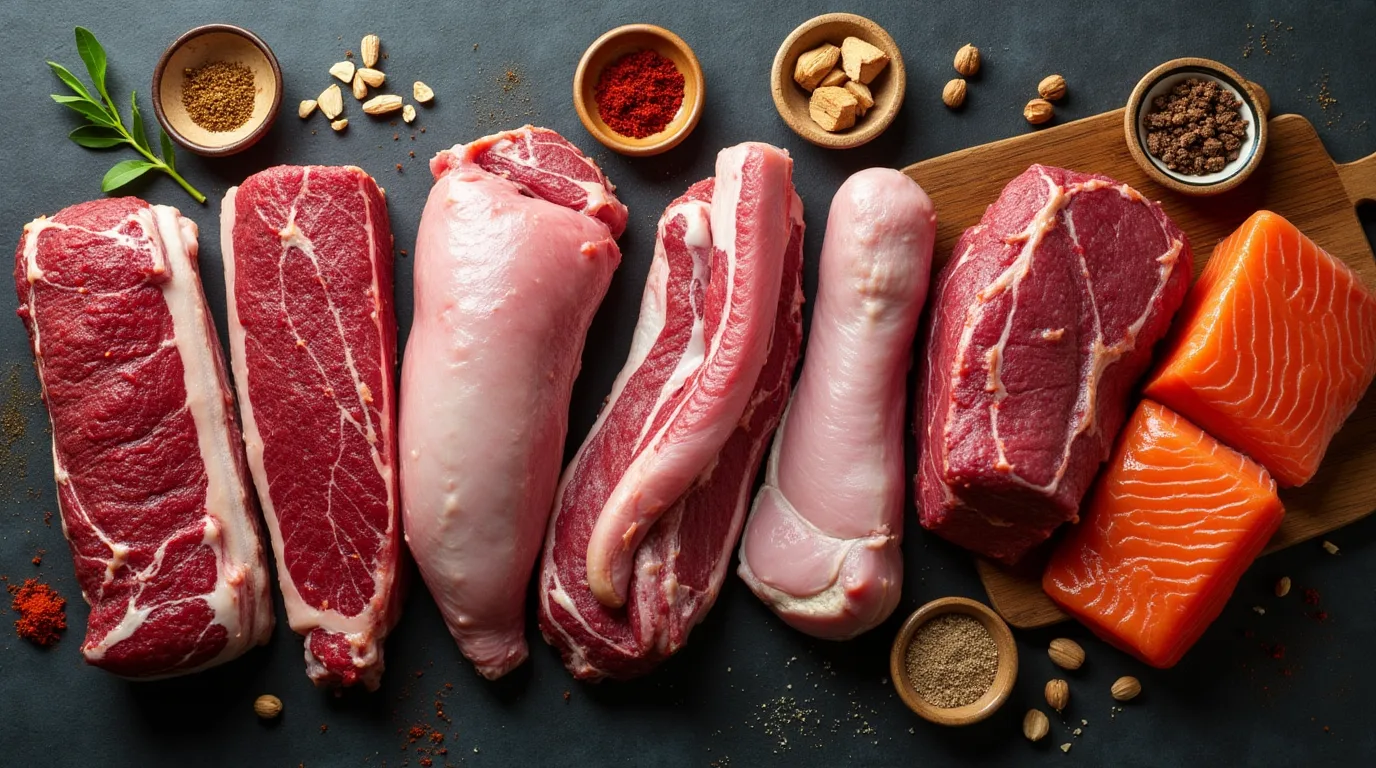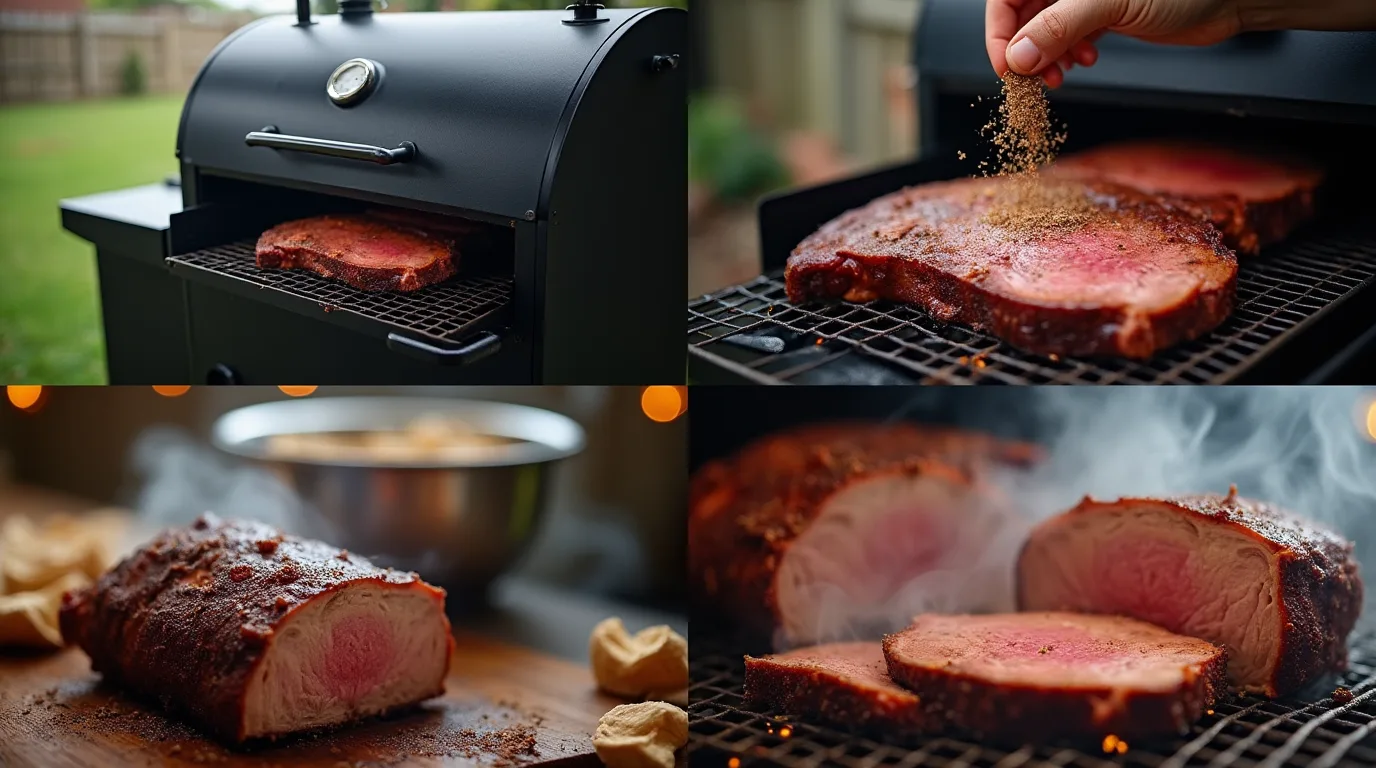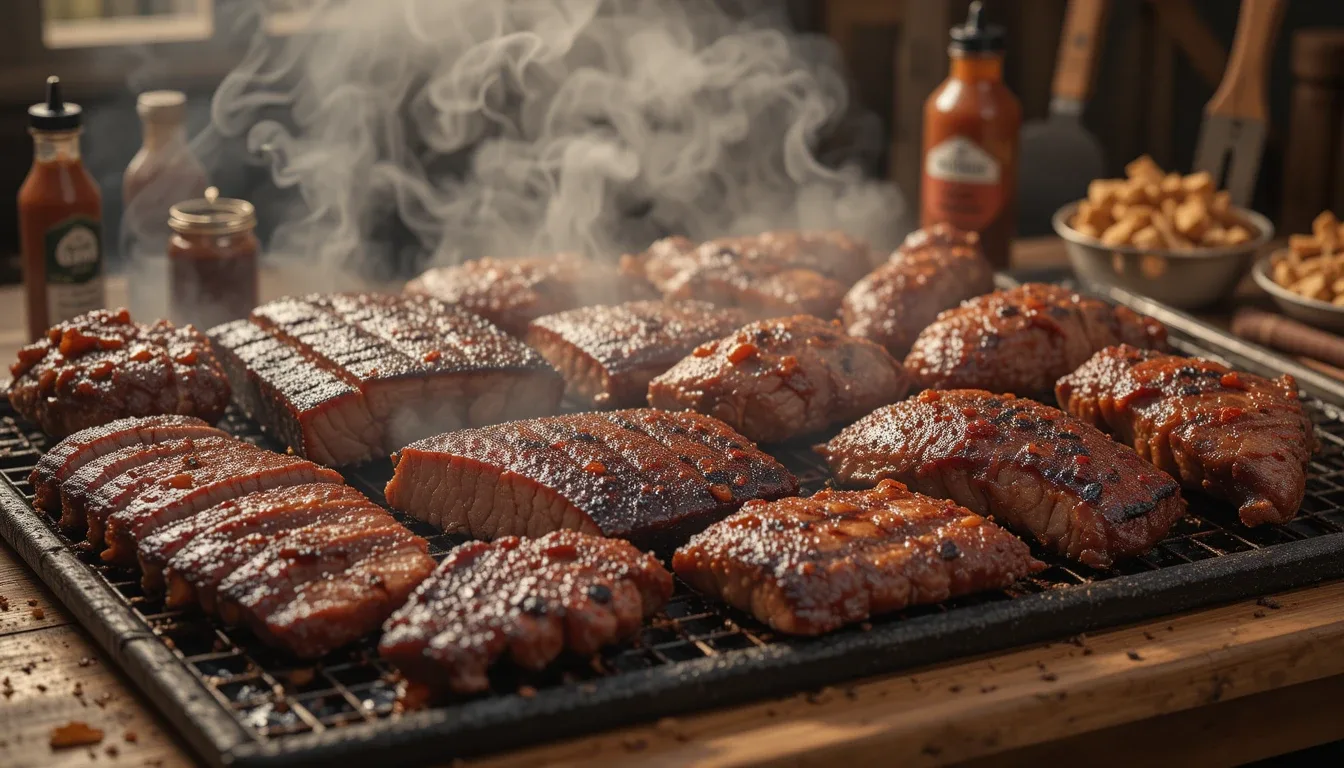Smoking meats is more than just a cooking method it’s an art form that transforms ordinary cuts into extraordinary feasts. Have you ever taken your first bite of perfectly smoked brisket or ribs, savoring the tender texture and deep, smoky flavor? That’s the magic we’re unlocking today with seven amazing meat choices guaranteed to elevate your BBQ game. Whether you’re a seasoned pitmaster or just starting out, this guide will show you how to achieve incredible flavor using simple techniques and the right cuts. From classic beef brisket to juicy chicken thighs, each option promises versatility and delicious results. So grab your smoker, pick your favorite wood chips, and let’s dive into creating meals that will leave your guests begging for seconds!
Table of Contents
Key Benefits of Best Meats to Smoke
Smoking meats is more than just a cooking technique it’s a journey to unlocking incredible flavors and textures that can’t be replicated by any other method. Here’s why this process deserves a place in your culinary repertoire:
- Enhanced Flavor: The slow infusion of smoke creates layers of taste that make every bite unforgettable. Whether you’re using hickory, applewood, or mesquite, the right wood chips can transform ordinary cuts into something extraordinary.
- Juicy Results Every Time: Unlike high-heat methods that can dry out the meat, smoking locks in moisture, leaving you with tender, succulent bites. Who doesn’t love juicy, fall-off-the-bone ribs or melt-in-your-mouth brisket?
- Healthier Cooking Option: Smoking uses lower temperatures and minimal added fats, making it a healthier alternative to frying while still delivering rich, satisfying flavors.
- Versatility Across Cuts: From beef brisket to lamb shoulders, chicken thighs to salmon fillets, almost any meat can benefit from the smoky treatment. This versatility means you can experiment endlessly without ever running out of ideas.
- Perfect for Gatherings: There’s nothing quite like firing up the smoker to bring people together. It’s not just about the food it’s about creating memories around the aroma of sizzling meat and the joy of sharing a meal.
Ready to dive in? In the next section, we’ll explore the ingredients you’ll need to get started on your smoking adventure. But first, take a moment to imagine the satisfaction of serving up perfectly smoked meats at your next gathering. Doesn’t that sound amazing? Let’s make it happen!
Ingredients for Your Best Meats to Smoke
Now that you’re ready to dive into the world of smoking, let’s explore seven incredible meats that will take your culinary skills to the next level. Whether you’re a fan of beef, chicken, lamb, or even fish, there’s something here for every taste bud.

1. Beef Brisket
- A staple in the smoking world, known for its rich, robust flavor.
- Cooked low and slow, brisket becomes tender and juicy, perfect for slicing thin or serving as pulled beef.
2. Beef Short Ribs
- These hearty ribs offer deep, beefy flavors with a satisfying chew.
- After hours in the smoker, they become irresistibly tender and packed with smoky goodness.
3. Chicken Thighs
- A budget-friendly option that doesn’t compromise on flavor.
- Retains moisture beautifully during the smoking process, making them ideal for experimenting with different spice blends.
4. Turkey Breast
- Perfect for special occasions or holiday meals.
- Smoked turkey boasts a deeper, more complex flavor compared to roasted versions.
- Serve it sliced alongside cranberry sauce for a festive touch.
5. Lamb Shoulder Chops
- Adds an elegant twist to your smoking repertoire.
- The natural gaminess of lamb pairs beautifully with bold spices and herbs.
- Impress your guests with this gourmet option.
6. Venison (Deer Meat)
- For those looking to try something unique, venison is lean yet incredibly flavorful.
- Smoking enhances its earthy notes, creating a dish that’s both rustic and refined.
7. Salmon Fillets
- A surprising but delightful choice for the smoker.
- Creates a flaky, smoky texture that’s perfect for salads, sandwiches, or standalone plates.
- Try pairing with a maple glaze for added sweetness.
Seasonings and Enhancements
Don’t forget the finishing touches! Here are some essentials to enhance your smoked meats:
- Dry Rubs: Mixtures of spices like paprika, garlic powder, and cayenne add depth before cooking.
- Marinades: Acidic bases such as vinegar or citrus juice tenderize while infusing flavor.
- Sauces: From sweet honey BBQ to spicy chipotle, sauces can elevate your dishes to new heights.
With these ingredients in hand, you’re set to create unforgettable meals. In the next section, we’ll walk through step-by-step instructions to ensure your smoker delivers nothing short of perfection. Stay tuned you’re just moments away from mastering the art of smoking!
Instructions: How to Smoke Your Meats Like a Pro
Now that you’ve chosen your meat and gathered your ingredients, it’s time to fire up the smoker! Don’t worry if this is your first time smoking meats is all about patience and a few key steps. Let’s break it down into an easy-to-follow process.

Step 1: Prepare Your Smoker
Before you start cooking, make sure your smoker is ready to go:
- Clean the Smoker: Remove any leftover ash or debris from previous uses.
- Choose Your Wood Chips: Different woods impart unique flavors. For example, hickory works well for beef, while applewood pairs beautifully with poultry.
- Set the Temperature: Most meats are smoked at temperatures between 225°F and 275°F (107°C–135°C). Adjust based on the cut of meat.
Step 2: Season Your Meat
This step sets the foundation for flavor:
- Pat the meat dry with paper towels to help the seasonings stick.
- Apply a generous layer of your chosen dry rub or marinade. Let it sit for at least 30 minutes (or overnight in the fridge) to allow the flavors to penetrate.
Step 3: Start Smoking
Here’s where the magic happens:
- Preheat the Smoker: Allow the smoker to reach your desired temperature before adding the meat.
- Add Wood Chips: Place soaked wood chips in the smoke box or directly on the heat source for consistent smoke production.
- Place the Meat: Arrange the meat on the racks, leaving enough space for airflow. This ensures even cooking.
Step 4: Monitor and Maintain
Patience is key when smoking meats:
- Check Temperatures Regularly: Use a digital meat thermometer to track internal temperatures. For instance, beef brisket should reach around 203°F (95°C) for optimal tenderness.
- Refill as Needed: Add more wood chips or fuel if the smoke starts to thin out.
- Avoid Opening the Lid Too Often: Every time you open the lid, you lose heat and extend the cooking time.
Step 5: Rest and Serve
Once your meat reaches the target temperature:
- Remove it from the smoker and let it rest for 30–60 minutes. This allows the juices to redistribute, ensuring maximum juiciness.
- Slice, shred, or serve whole, depending on the cut.
- Drizzle with your favorite sauce or garnish with fresh herbs for added flair.
Tips for Success
- Start Small: If you’re new to smoking, begin with quicker-cooking items like chicken thighs or salmon fillets before tackling larger cuts.
- Experiment with Woods: Try different wood combinations to find your perfect flavor profile.
- Stay Patient: Low and slow cooking builds layers of flavor don’t rush the process!
With these instructions, you’re now equipped to create mouthwatering, smoky masterpieces. In the next section, we’ll share some pro tips and variations to take your skills even further. Keep going you’re almost there!
Pro Tips and Variations: Taking Your Smoking Game to the Next Level
You’ve got the basics down, but let’s take your smoking skills from good to great! Here are some expert tips and creative variations to help you refine your technique and expand your repertoire.
Pro Tips for Perfect Results
- Invest in a Good Thermometer: A high-quality digital thermometer is your best friend. It ensures your meat reaches the perfect internal temperature without overcooking.
- Soak Your Wood Chips: Soaking wood chips in water for at least 30 minutes before use creates longer-lasting smoke, preventing them from burning too quickly.
- Use the Rule of Thirds: For larger cuts like brisket or turkey breast, wrap the meat in foil during the last third of cooking time to speed up the process while keeping it moist.
- Don’t Forget Ventilation: Adjust the vents on your smoker to control airflow. More airflow means hotter temperatures, while less airflow keeps things cooler.
Creative Variations to Try
Once you’re comfortable with the basics, it’s time to get adventurous! Here are a few ideas to spice things up:
- Experiment with Rubs: Swap out traditional rubs for international flavors. Think Moroccan spices for lamb shoulder or Korean gochujang for chicken thighs.
- Try Different Woods: Mix and match wood types to create unique flavor profiles. For example, pairing cherry wood with applewood can add sweetness to beef ribs.
- Add Fruit-Wood Combinations: Applewood or peachwood works wonders for salmon, adding a subtle fruity undertone that complements its natural richness.
- Glaze Toward the End: Brush on glazes or sauces during the last 15–20 minutes of cooking to prevent them from burning but still achieve a caramelized finish.
Troubleshooting Common Issues
Even pros encounter hiccups sometimes. Here’s how to handle common problems:
- Meat Too Dry? Ensure you’re maintaining proper moisture levels by using a water pan inside the smoker or wrapping tougher cuts in foil partway through cooking.
- Smoke Flavor Too Strong? Reduce the amount of wood chips or switch to milder woods like alder or maple.
- Uneven Cooking? Rotate the meat halfway through the process to ensure all sides cook evenly.
By incorporating these pro tips and trying out new variations, you’ll not only improve your smoking skills but also keep your meals exciting and fresh. Ready to push your limits? Let’s move on to serving suggestions because presentation matters just as much as taste!
Serving Suggestions: Turning Your Best Meats to Smoke into a Feast
You’ve put in the time and effort to smoke your meats to perfection now it’s time to serve them up in style! The right presentation and pairing can elevate your dish from delicious to unforgettable. Here are some creative serving ideas to make your smoked meats shine.
Classic Side Dishes
Pair your Best Meats to Smoke with these timeless sides for a crowd-pleasing meal:
- Coleslaw: A creamy or vinegar-based coleslaw adds freshness and crunch.
- Baked Beans: Sweet, smoky baked beans complement the rich flavors of beef and poultry.
- Cornbread: Serve warm cornbread on the side for soaking up savory juices.
- Mashed Potatoes: Creamy mashed potatoes provide a comforting base for pulled meats or shredded chicken.
Modern Twists
For those looking to add a modern flair:
- Grain Bowls: Toss smoked chicken or turkey breast with quinoa, roasted veggies, and a citrus-tahini dressing.
- Tacos or Wraps: Use smoked meats as fillings for tacos, wraps, or burritos. Top with fresh salsa, avocado, or pickled onions.
- Salads: Shred smoked salmon or turkey breast and toss it into a mixed greens salad with a vinaigrette for a lighter option.
Garnishes and Sauces
Don’t forget the finishing touches that take your dish to the next level:
- Fresh Herbs: Sprinkle chopped parsley, cilantro, or thyme over your meats for added color and aroma.
- Custom Sauces: Offer a variety of sauces, such as tangy BBQ, spicy chipotle, or honey mustard, so guests can customize their experience.
- Citrus Zest: Add a burst of brightness by zesting lemon or lime over your smoked fish or poultry.
Presentation Ideas
Presentation matters just as much as taste:
- Family Style: Arrange large platters of sliced brisket, pulled turkey, or smoked chicken thighs on a wooden board for a rustic touch.
- Individual Portions: Serve smaller portions on plates with garnishes artfully placed for an elegant look.
- DIY Stations: Set up a DIY station where guests can build their own sandwiches, tacos, or bowls using your smoked meats as the star ingredient.
With these serving suggestions, you’ll turn your smoked meats into a feast that wows every guest. Whether you stick to classics or experiment with new ideas, remember to have fun and enjoy the process. In our final section, we’ll wrap things up with some parting thoughts. Stay tuned!
Conclusion: Your Smoking Journey Awaits
Congratulations! You’ve made it through the steps to create some of the best smoked meats that will leave your friends and family craving more. Whether you’re a seasoned pitmaster or just starting out, mastering the art of smoking opens up endless possibilities for delicious, flavorful meals.
Why Smoking Matters
Smoking isn’t just about cooking it’s about creating experiences. The slow infusion of smoky goodness transforms ordinary cuts into extraordinary dishes. From tender brisket to flaky salmon, each bite tells a story of patience, passion, and precision. And let’s not forget the aroma alone is enough to bring people together!
Keep Exploring
Now that you’ve got the basics down, don’t be afraid to experiment. Try new wood combinations, bold seasonings, or unique recipes. Every smoker has its quirks, so embrace them and make the process your own. Remember, practice makes perfect, and every attempt brings you closer to becoming a true BBQ guru.
Your Turn
The world of smoking is vast and full of opportunities to explore. So grab your favorite cut of meat, fire up your smoker, and dive in. With these techniques, tips, and serving ideas, you’re ready to impress anyone lucky enough to taste your creations. Happy smoking, and here’s to many memorable meals ahead!
Before we wrap up completely, let’s address a few common questions in our FAQ section. Stay tuned for answers to all your burning (pun intended) questions!

Best Meats To Smoke
Ingredients
Beef Brisket
- A staple in the smoking world known for its rich, robust flavor.
- Cooked low and slow brisket becomes tender and juicy, perfect for slicing thin or serving as pulled beef.
Beef Short Ribs
- These hearty ribs offer deep beefy flavors with a satisfying chew.
- After hours in the smoker they become irresistibly tender and packed with smoky goodness.
Chicken Thighs
- A budget-friendly option that doesn’t compromise on flavor.
- Retains moisture beautifully during the smoking process making them ideal for experimenting with different spice blends.
Turkey Breast
- Perfect for special occasions or holiday meals.
- Smoked turkey boasts a deeper more complex flavor compared to roasted versions.
- Serve it sliced alongside cranberry sauce for a festive touch.
Lamb Shoulder Chops
- Adds an elegant twist to your smoking repertoire.
- The natural gaminess of lamb pairs beautifully with bold spices and herbs.
- Impress your guests with this gourmet option.
Venison (Deer Meat)
- For those looking to try something unique venison is lean yet incredibly flavorful.
- Smoking enhances its earthy notes creating a dish that’s both rustic and refined.
Salmon Fillets
- A surprising but delightful choice for the smoker.
- Creates a flaky smoky texture that’s perfect for salads, sandwiches, or standalone plates.
- Try pairing with a maple glaze for added sweetness.
Seasonings and Enhancements
- Don’t forget the finishing touches! Here are some essentials to enhance your smoked meats:
- Dry Rubs: Mixtures of spices like paprika garlic powder, and cayenne add depth before cooking.
- Marinades: Acidic bases such as vinegar or citrus juice tenderize while infusing flavor.
- Sauces: From sweet honey BBQ to spicy chipotle sauces can elevate your dishes to new heights.
- With these ingredients in hand you’re set to create unforgettable meals. In the next section, we’ll walk through step-by-step instructions to ensure your smoker delivers nothing short of perfection. Stay tuned you’re just moments away from mastering the art of smoking!
Instructions
Step 1: Prepare Your Smoker
- Before you start cooking, make sure your smoker is ready to go:
- Clean the Smoker: Remove any leftover ash or debris from previous uses.
- Choose Your Wood Chips: Different woods impart unique flavors. For example, hickory works well for beef, while applewood pairs beautifully with poultry.
- Set the Temperature: Most meats are smoked at temperatures between 225°F and 275°F (107°C–135°C). Adjust based on the cut of meat.
Step 2: Season Your Meat
- This step sets the foundation for flavor:
- Pat the meat dry with paper towels to help the seasonings stick.
- Apply a generous layer of your chosen dry rub or marinade. Let it sit for at least 30 minutes (or overnight in the fridge) to allow the flavors to penetrate.
Step 3: Start Smoking
- Here’s where the magic happens:
- Preheat the Smoker: Allow the smoker to reach your desired temperature before adding the meat.
- Add Wood Chips: Place soaked wood chips in the smoke box or directly on the heat source for consistent smoke production.
- Place the Meat: Arrange the meat on the racks, leaving enough space for airflow. This ensures even cooking.
Step 4: Monitor and Maintain
- Patience is key when smoking meats:
- Check Temperatures Regularly: Use a digital meat thermometer to track internal temperatures. For instance, beef brisket should reach around 203°F (95°C) for optimal tenderness.
- Refill as Needed: Add more wood chips or fuel if the smoke starts to thin out.
- Avoid Opening the Lid Too Often: Every time you open the lid, you lose heat and extend the cooking time.
Step 5: Rest and Serve
- Once your meat reaches the target temperature:
- Remove it from the smoker and let it rest for 30–60 minutes. This allows the juices to redistribute, ensuring maximum juiciness.
- Slice, shred, or serve whole, depending on the cut.
- Drizzle with your favorite sauce or garnish with fresh herbs for added flair.
Tips for Success
- Start Small: If you’re new to smoking, begin with quicker-cooking items like chicken thighs or salmon fillets before tackling larger cuts.
- Experiment with Woods: Try different wood combinations to find your perfect flavor profile.
- Stay Patient: Low and slow cooking builds layers of flavor don’t rush the process!
- With these instructions, you’re now equipped to create mouthwatering, smoky masterpieces. In the next section, we’ll share some pro tips and variations to take your skills even further. Keep going you’re almost there!
Notes
Nutrition Information (Per Serving)
(Based on average values for selected meats)- Calories: 350–500 kcal
- Fat: 20–30g
- Protein: 35–45g
- Carbs: 5–10g (from rubs or marinades)
- Sodium: 500–800mg (depends on seasoning)
Why This Recipe Works
This guide to smoking meats is designed to help you unlock incredible flavor while achieving tender, juicy results every time. Whether you’re working with beef brisket, chicken thighs, lamb shoulder, or salmon fillets, the step-by-step instructions and pro tips ensure success. Plus, versatile serving suggestions and creative variations keep your meals exciting and fresh. Ready to smoke? Fire up your smoker and let the aroma of perfectly cooked meats fill your home!FAQs: Answering Your Burning Questions
Before you fire up the smoker, let’s tackle some common questions to ensure you’re fully prepared for your smoking adventure. Whether you’re a beginner or looking to refine your technique, these FAQs have got you covered.
Q: What is the best cut of meat for beginners?
Starting with something forgiving and easy to manage is key. For beginners, we recommend chicken thighs or beef brisket. Both are versatile, forgiving cuts that deliver delicious results even if you’re still mastering temperature control.
Q: How long should I smoke my meat?
Cooking times depend on the type and size of the meat, as well as your desired level of doneness. As a general rule:
- Chicken thighs: 2–3 hours at 225°F (107°C)
- Beef brisket: 1.5–2 hours per pound at 225°F (107°C)
- Salmon fillets: 45–60 minutes at 225°F (107°C)
Always use a meat thermometer to check internal temperatures for safety and tenderness.
Q: Can I use an electric smoker instead of a charcoal one?
Absolutely! Electric smokers are convenient, user-friendly, and perfect for those who want consistent results without constant monitoring. While they may lack the hands-on experience of charcoal smokers, they still produce incredible flavor when paired with the right wood chips.
Q: Why does my smoked meat sometimes turn out dry?
Dryness often happens due to overcooking or insufficient moisture during the process. To prevent this:
- Maintain proper humidity by using a water pan in your smoker.
- Wrap tougher cuts like brisket in foil during the final stages of cooking (the “Texas crutch” method).
- Let the meat rest after smoking to allow juices to redistribute.
Q: Which wood chips should I use for each type of meat?
Choosing the right wood can make all the difference:
- Hickory: Best for beef and game meats; adds a strong, classic BBQ flavor.
- Applewood: Perfect for poultry and lamb; imparts a mild sweetness.
- Mesquite: Ideal for bold flavors like beef ribs; use sparingly as it can overpower delicate meats.
- Cherrywood: Great for lamb and salmon; offers a fruity, slightly sweet note.
Q: Can I smoke vegetables alongside my meats?
Yes, absolutely! Smoking vegetables adds depth and complexity to their natural flavors. Try smoking bell peppers, onions, or even Brussels sprouts for a unique side dish. Just be mindful of shorter cooking times compared to meats.
Q: How do I clean my smoker after use?
Proper maintenance ensures longevity and better performance:
- Allow the smoker to cool completely before cleaning.
- Remove ash and debris from the bottom.
- Wipe down surfaces with a damp cloth and mild soap.
- Store wood chips and accessories in a dry place to prevent moisture buildup.
With these answers, you’re now equipped to handle any challenge that comes your way. Happy smoking, and remember practice makes perfect! If you have more questions, feel free to reach out. We’re always here to help.
Related Recipes:

